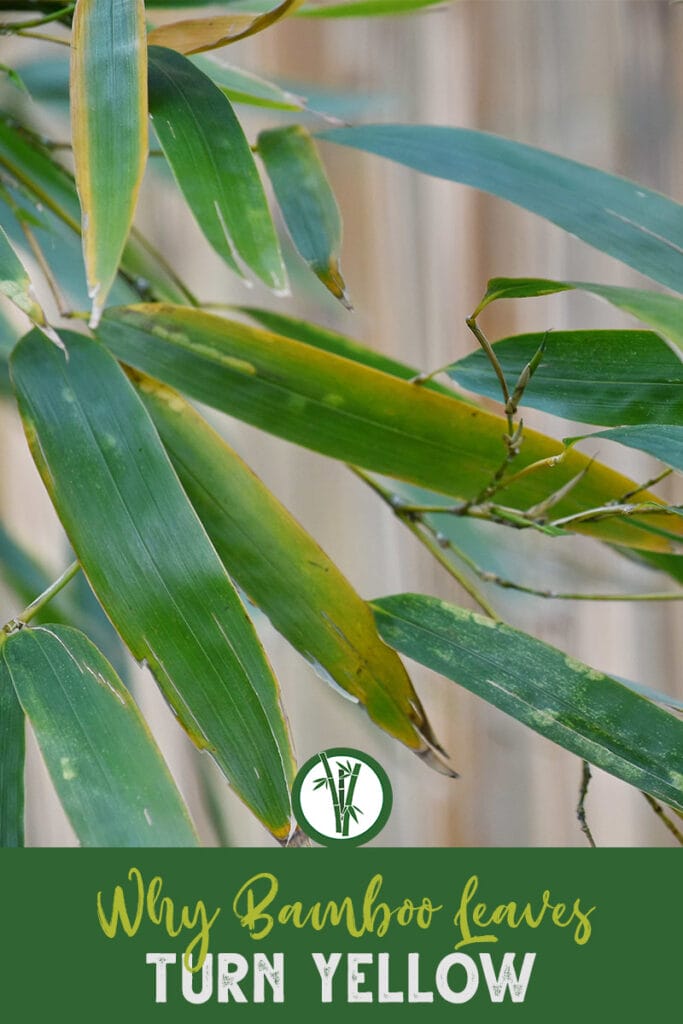
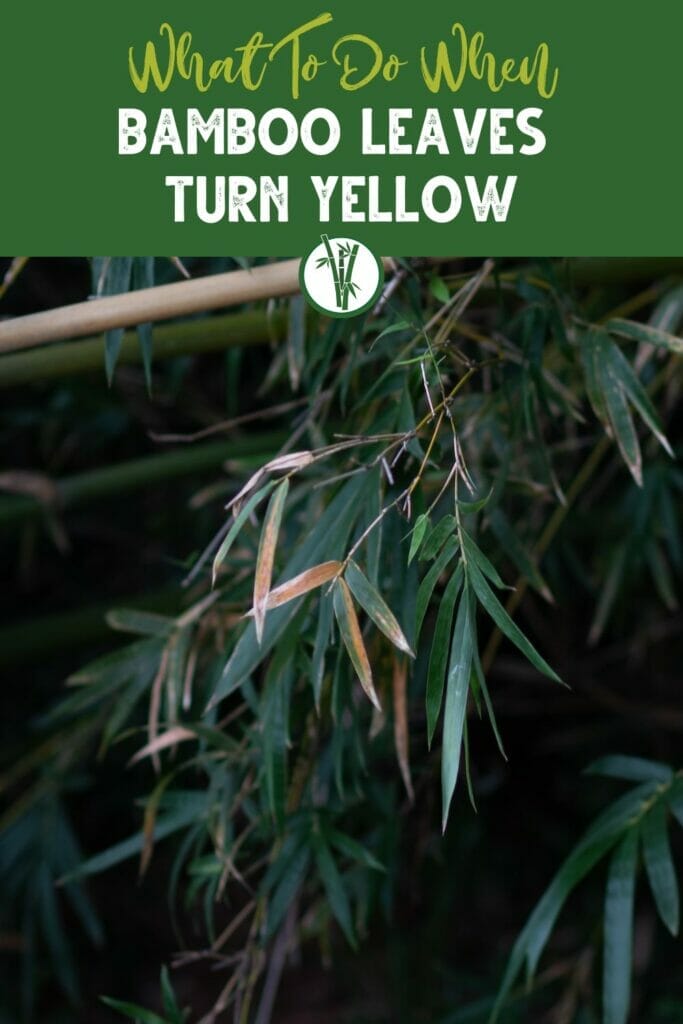
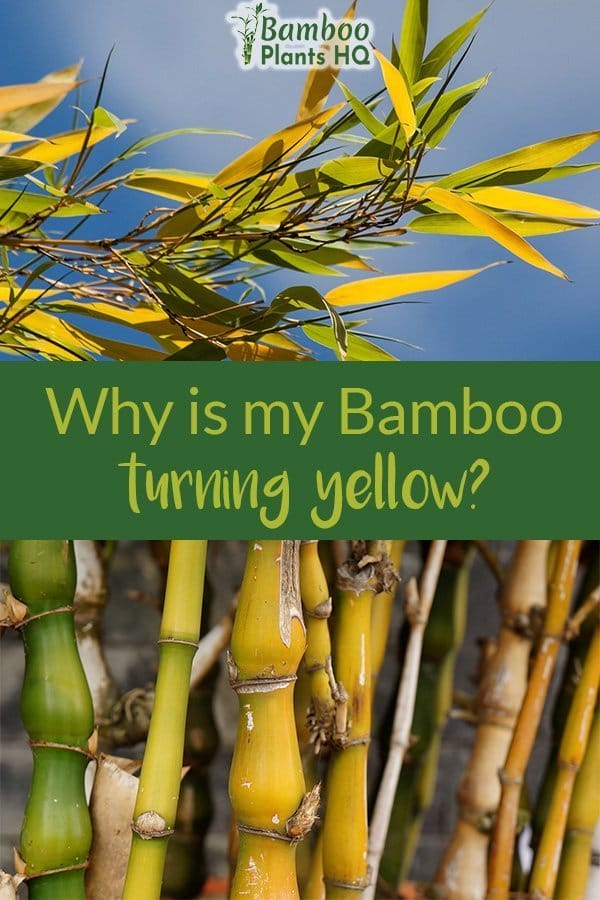
If you are wondering why your bamboo leaves or culms are turning yellow, don’t panic!
Watching your bamboo plant leaves turn yellow can be alarming, but most of the time, it’s actually a normal occurrence. The same goes for bamboo culms that become yellow. However, it could be that you don’t give your bamboo the required conditions it needs.
I want to clarify: In this post, we’re talking about real bamboo plants, but we have written about lucky bamboo as well and you can read about that here!
First, let’s have a look at what’s normal bamboo yellowing. Maybe this will already give you peace of mind.
What’s considered normal yellowing of bamboo
Although bamboo is an evergreen plant, it can still get a few yellow leaves and culms. That’s totally common.
Normal bamboo leaf yellowing
Like many other plants, bamboo sheds its leaves and grows new ones. What happens is that the bamboo will cut off the nutrients in the leaves to use it in other places. Due to this lack of nutrients, some of the leaves turn yellow and fall off.
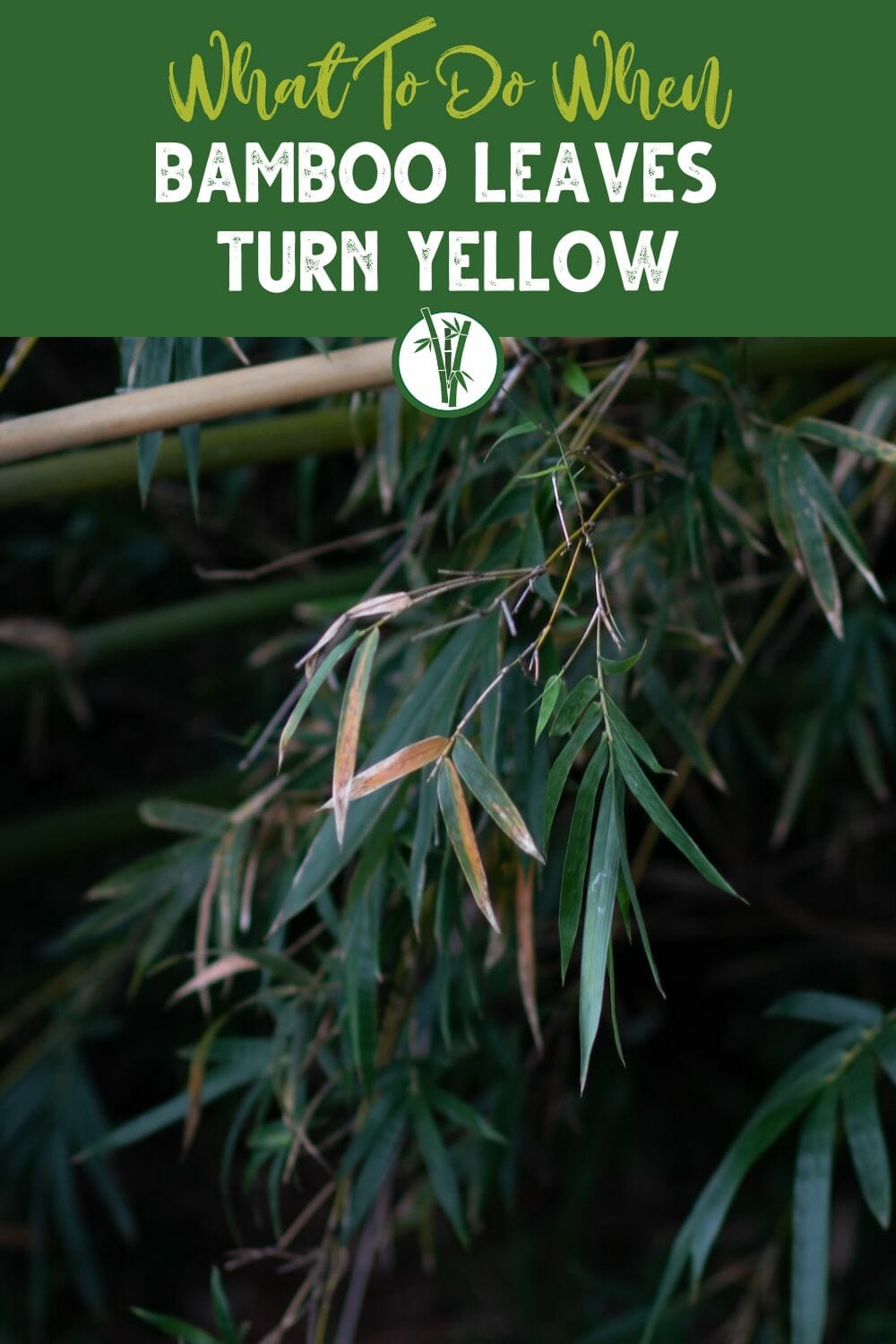
Because bamboo is evergreen, most species lose their leaves very gradually and replace those leaves with new ones. In this respect, bamboo plants have a mixture of green and yellow leaves most of the time. In spring, you may experience a larger yellowing than in other seasons. Spring is basically the fall for bamboo when it comes to its leaves.
With this being said, there are a few species that drop large amounts of leaves at one time, and this can be concerning… Typically a little research into your specific variety will give you peace of mind!
If, however, all of the leaves turn yellow and fall out without any green leaves following, you may have a bigger problem.
Another indicator of an existing problem is when the leaf tips turn brown. This discoloration on the leaves can be caused by a lack of water or wind damage.
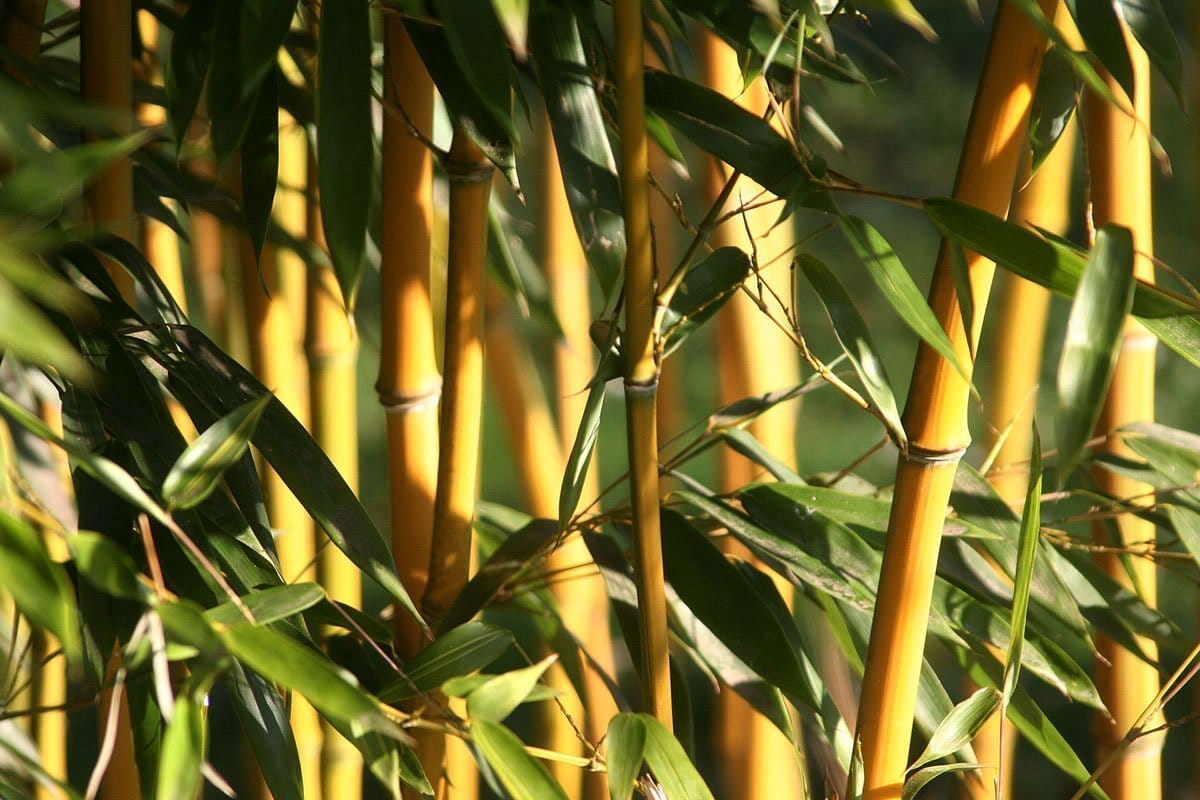
Normal bamboo culm yellowing
Ok, this may sound super ridiculous but: do you have a yellow bamboo variety? Some bamboo species start with green culms and turn yellow as they mature. I know most people pick their bamboo variety but maybe you couldn’t.
If it’s not a yellow bamboo, it may be still normal. Sometimes bamboo plants shoot just before the colder season. Depending on your area and the hardiness, those fresh shoots may die off when the temperature drops.
So, don’t panic if you have younger culms that turn yellow and maybe even brown. It’s kinda normal. Just clear them out by trimming them. This way they don’t “ruin the view”.
What species have more yellow leaves or culms than others?
As mentioned above, some species develop more yellow leaves than others. This goes for Phyllostachys Aurea (also known as Fish Pole Bamboo or Golden Bamboo) and Phyllostachys Edulis Moso (commonly used for bamboo fabrics). Both will lose a larger amount of leaves in spring.
Golden Bamboo is one of the most common bamboos in the United States. It grows upright and is very strong, as well as useful. Phyllostachys Edulis Moso is not as common in the United States but its characteristics are perfect to create bamboo threads from it.
Fargesia Murielae, also known as Umbrella Bamboo, will drop more leaves in fall. So it’s behaving like trees.
Still Concerned? Let’s do troubleshooting!
If you still believe that the yellowing is a problem and not just a natural part of your plant’s lifecycle, it’s time to start troubleshooting.
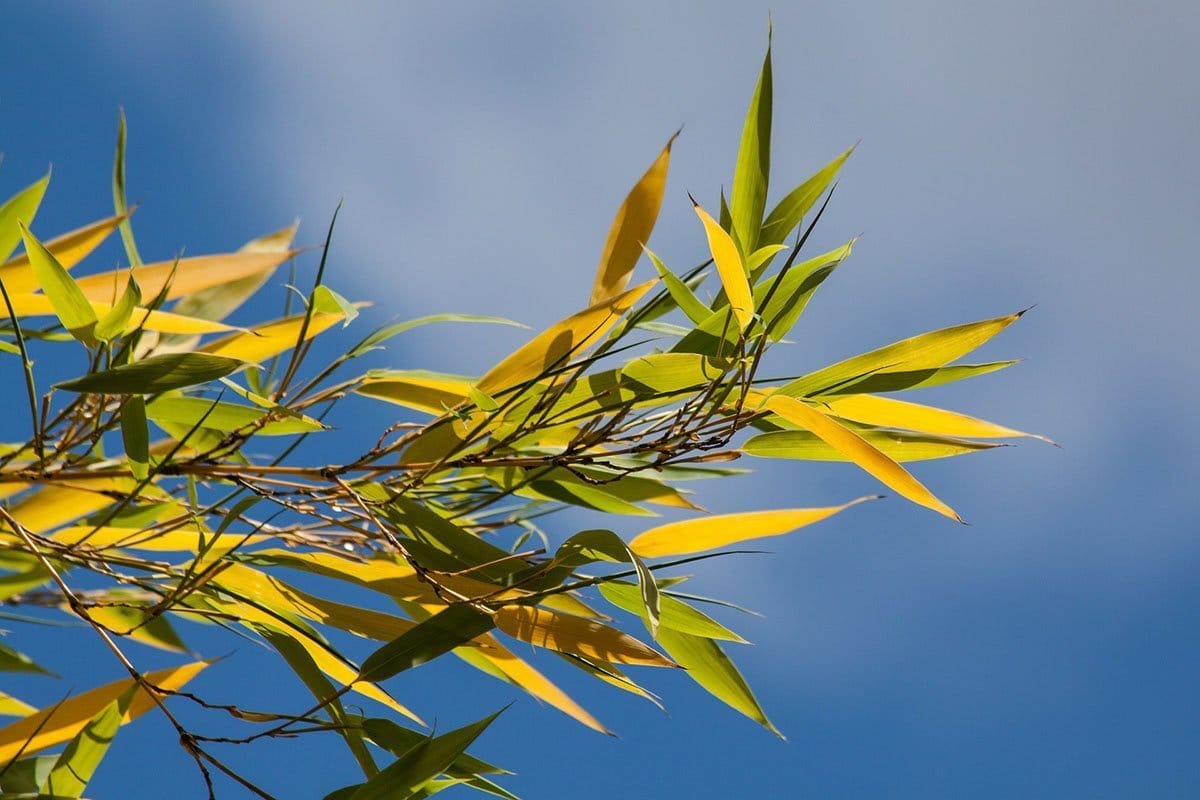
1. Fresh bamboo leaves are yellow
First, take a good look at the newest leaves (if you can distinguish them). If these leaves are turning yellow, it may indicate that the plant is lacking in iron. That’s a common problem in soil that is too alkaline.
Although most species can do all pH levels, they mostly prefer slightly acidic soil, though.
If you’re concerned about the pH level of your soil, you can purchase a pH testing kit. We would recommend getting one like this. Then you can test the soil around the base of the plant.
Our Recommendation
If you’re not sure what pH level your soil has, you can simply test it with a tool. It’s the easiest way to find out if you need to work on your soil before planting your bamboo.
If your soil turns out to be alkaline, you should feed your plant something more acidic:
- This can be an ericaceous compost made with coffee grounds, oak leaves, or pine needles. You can add a layer or mix it into the existing soil. This way you can change the overall soil condition.
- Another way would be adding an acidic plant food. You can purchase a fertilizer with Chelate Iron* or this organic iron-tone fertilizer*. and add this to the soil around your plant. Be careful to not use too much fertilizer, though. Bamboo does not like over-fertilizing.
- Instead of iron, you can also add sulfur to make the soil more acidic. You can get a 5 lbs bag on Amazon* and add a bit every once in a while if you have too alkaline soil in your garden.
2. Older bamboo leaves are yellowing
If older leaves are primarily the ones that turn yellow (and you don’t believe it to be natural leaf drop), then you may want to apply a fertilizer with nitrogen.
So, the soil doesn’t provide enough nutrients to the bamboo. That’s why you need to fertilize.
There are times when fertilizers should be applied. Although it can be confusing as to when exactly they need food, watching for the first signs of yellowing can be a good indicator – especially for the nitrogen.
You can add commercial fertilizer or make your own bamboo plant food.
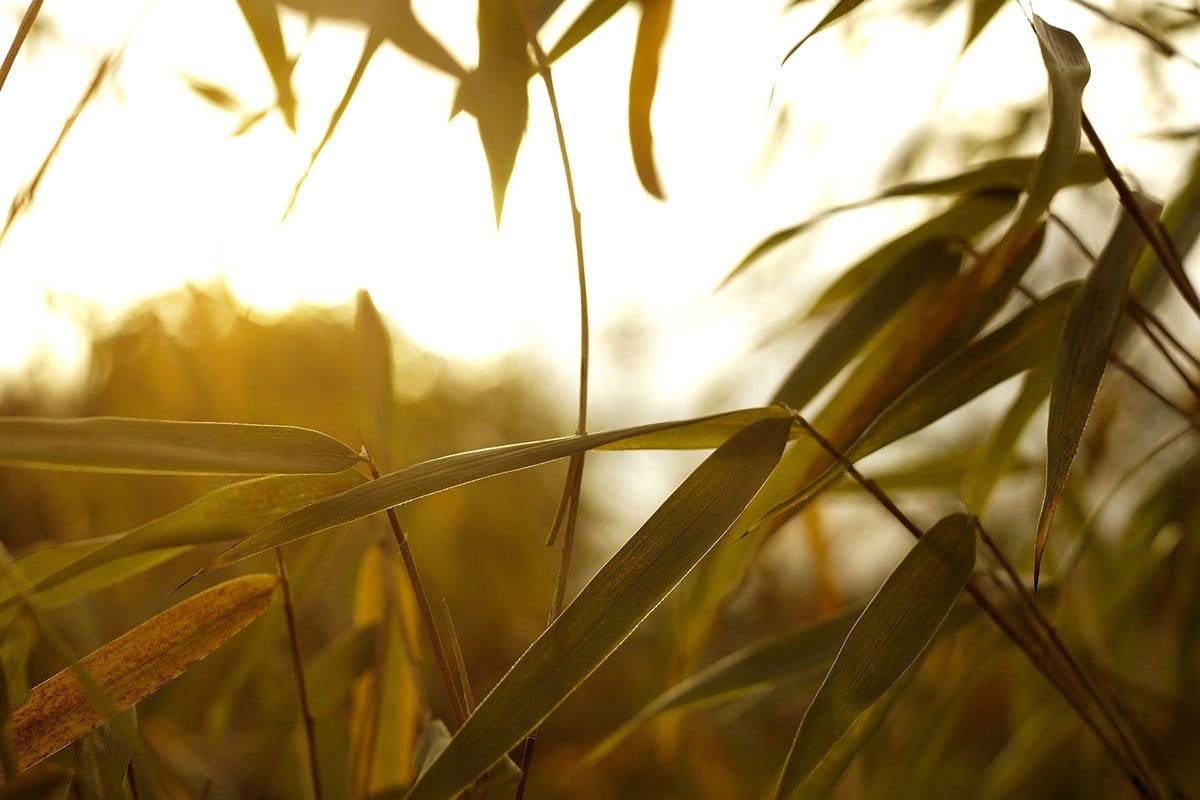
3. Bamboo leaves turn yellow with brown tips
If you spot a lot of yellow-brown leaves and the soil is dry, you are not keeping up the irrigation game. Bamboo plants need a lot of water, so you may need to increase your watering frequency.
If you are too busy to water manually, you should seriously consider a drip irrigation system in order to give your plants what they need.
You also should stop yourself from raking up the leaves on the ground, because they keep the soil moist.
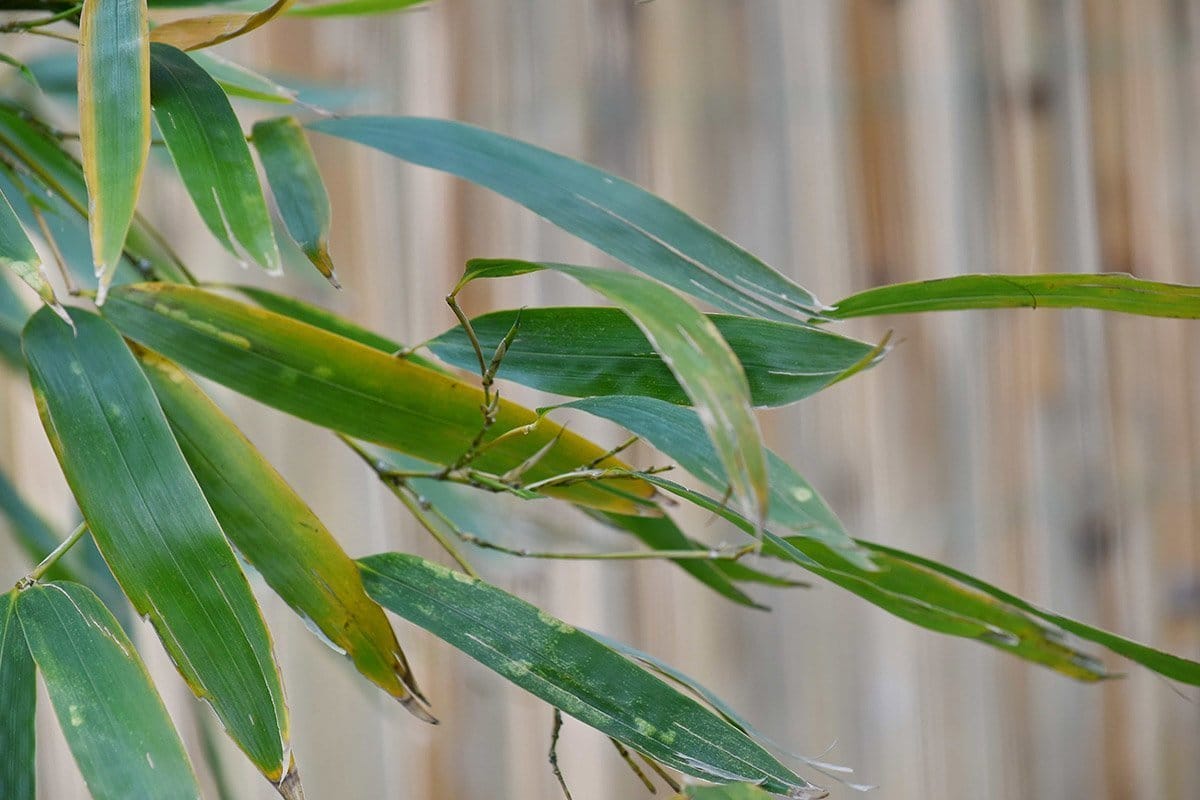
4. Bamboo leaves have yellow-pale spots
Maybe your problem actually is pest-related. If you see yellowish-pale spots on the bamboo leaves, it is very likely a mites infestation.
They are hard to see because they are very tiny. However, they suck the life out of the leaf. So, you can easily spot those areas.
There are many ways to get rid of them. You can pressure wash the plants with water or insecticidal soap or you can use neem oil.
5. Yellow bamboo leaves and culms
If you water regularly and the soil seems too moist or becomes water-logged, you need to do something with the soil again. Bamboo needs well-draining aerated soil.
You should apply organic compost every now and then. It will help to open up heavy clay soil so that it drains better. In addition, it provides more nutrients to the bamboo.
Pin it for later!
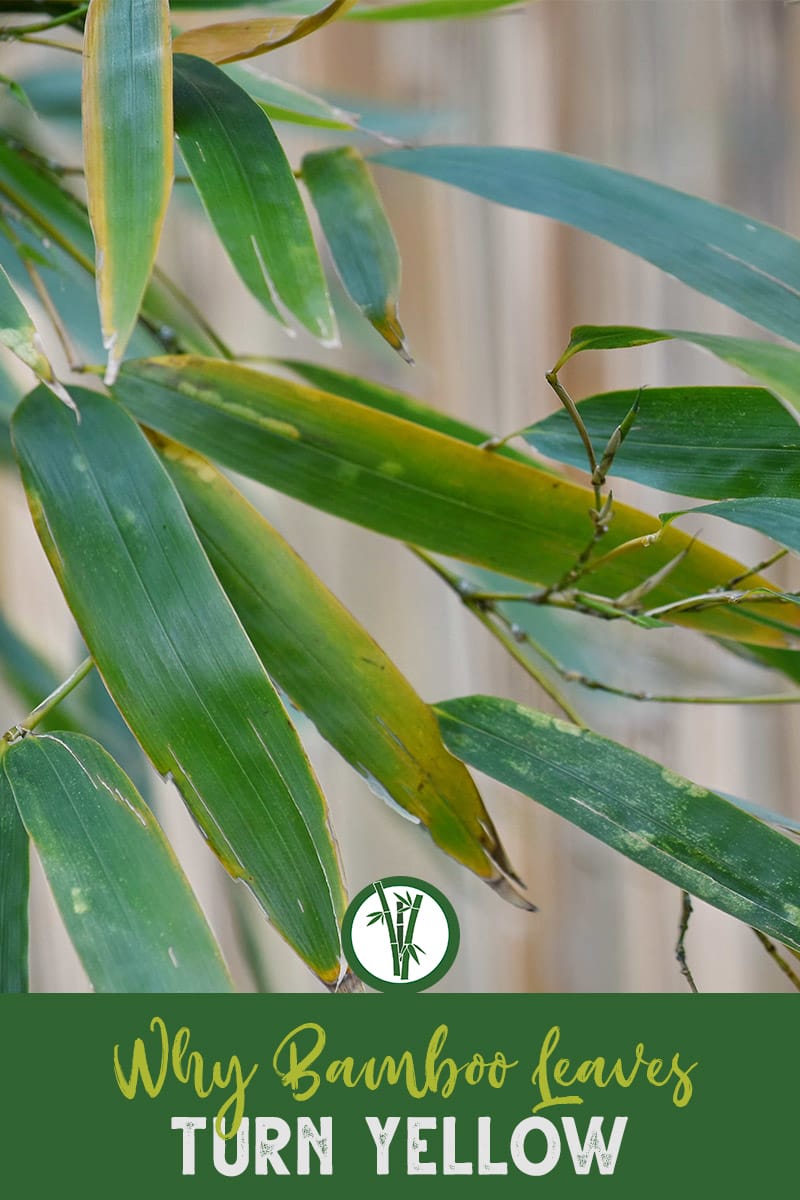
Other reasons why your bamboo plants are turning yellow
There still could be more reasons why your bamboo is turning yellow. Because there are so many little factors that could influence your bamboo’s health, we have to let you determine if one of these could be an issue.
It might be that your bamboo is just planted at the wrong spot. Maybe it is too sunny or the contrary. It could also be too windy for the stems or other chemicals used in the surrounding environment.
Obviously, soggy soil can be amended, but some things like too much sun or not enough can be difficult to remedy.
Again, it always depends on the bamboo species you have in your backyard. The trick with the acidic soil may not apply to you because you have Shibatea bamboo. Your Chimonobambusa bamboo may turn yellow because you placed it in direct sunlight, which on the other hand, Phyllostachys bamboo would love.
We hope this will help you to take care of your yellowing bamboo plants!

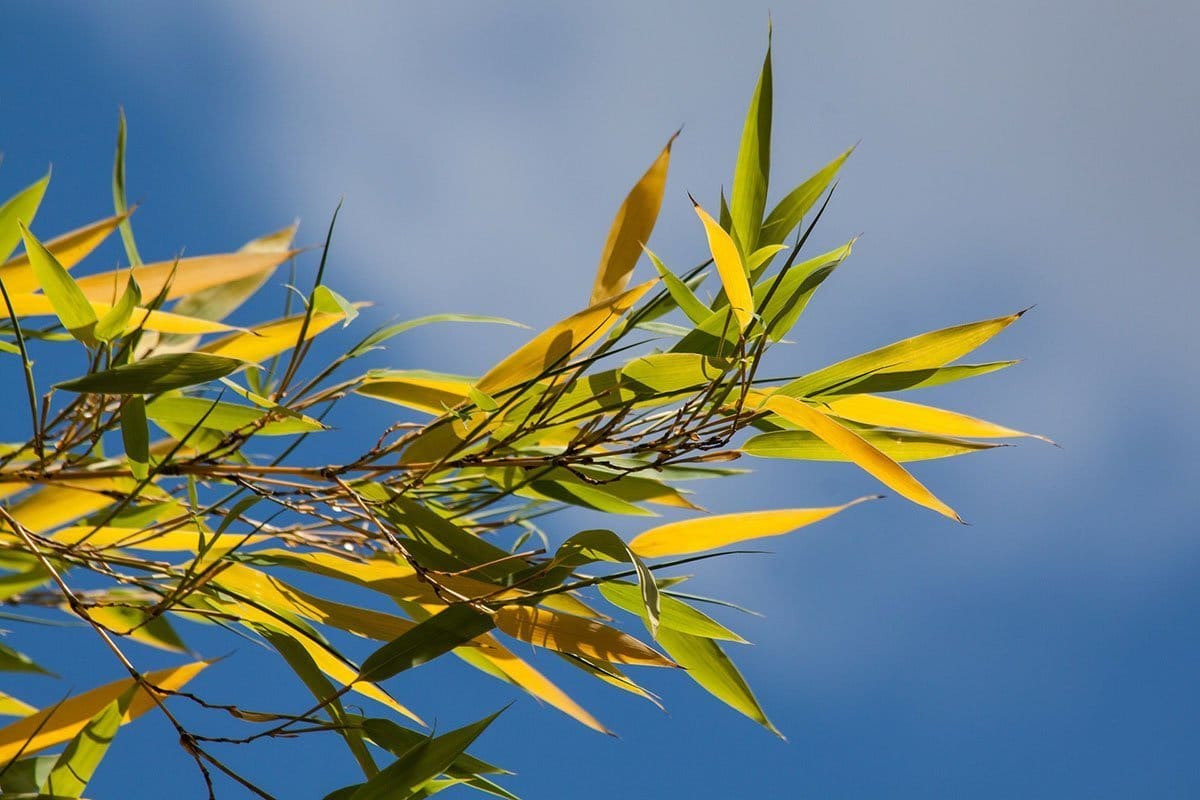

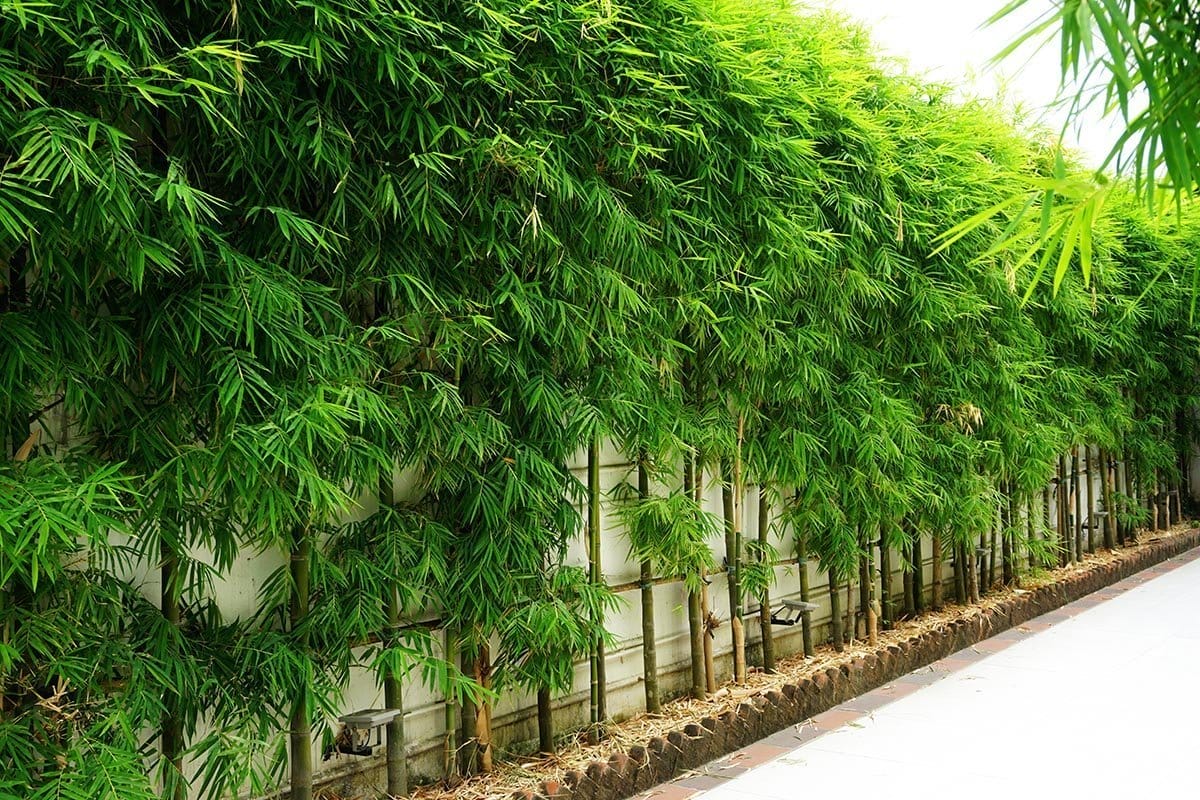
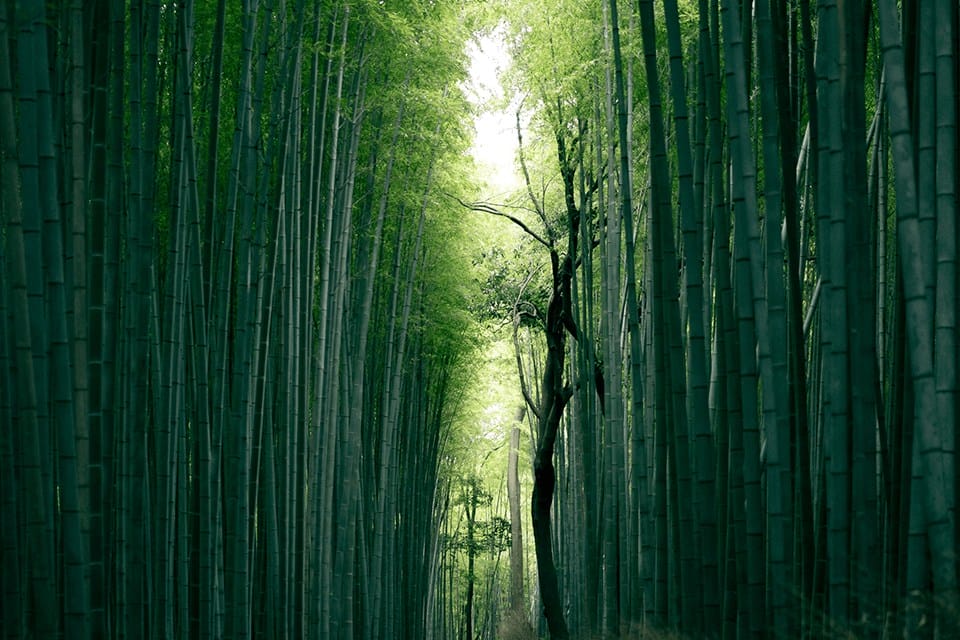
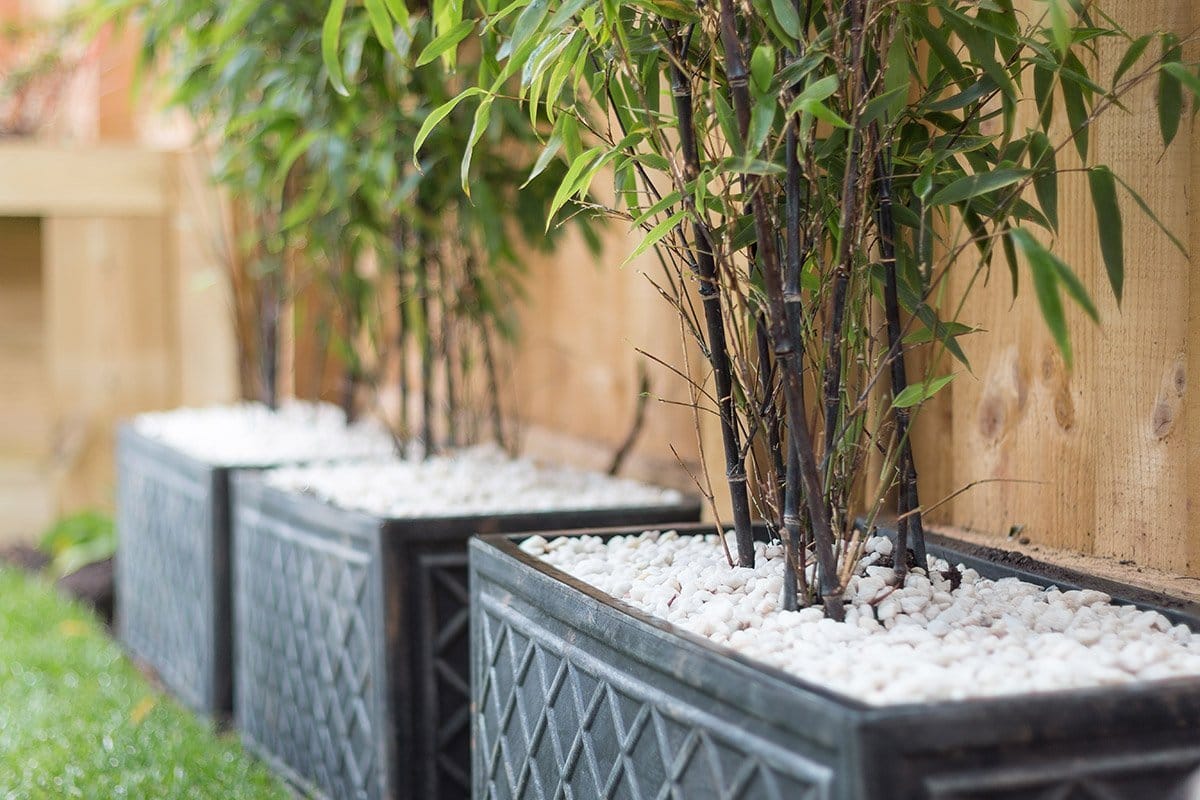
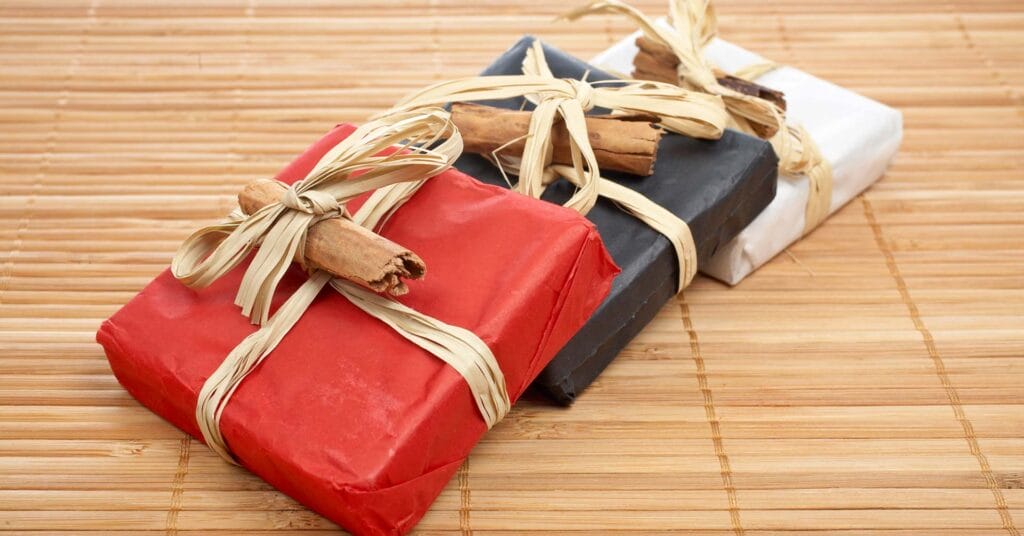
36 Comments
We purchased several bamboo in March that we use for a on our deck. They are 10-12 feet tall and we plan to keep them in pots. Some of the plants are turning yellow and am concerned this may be a sign of disease. Some whole stocks have yellowed. It has been more windy here than usual, and wonder whether that may be the problem. Are there tips for Spring care of bamboo that I should try. We have a drip watering system. Thank you!
Hi Linda, there are plenty of tips in the article. Are the pots draining well? Have you used too much fertilizer? Are you watering enough? March isn’t long ago so your plant isn’t established yet. It might be even still signs of the “transplantation stress”.
I’ve purchased Bissetti Bamboo about 4 weeks ago (8 in total) and have been planted in large planters. Since receiving the Bamboo the leaves have been turning yellow and dropping off, some more than others. New shoots have been growing but also yellow? The bamboo have been provided with plenty of water and food. Could they be diseased or simply adjusting to the new environment?
Hi Andrew, 4 weeks is still quite a short time so they may still adjust. Shoots start in a yellow-greenish color with reddish sheath tips. They are greener the more established the plants are. Don’t water and fertilize too much. Keep the soil moist and only feed once in spring and once at the end of summer. It’s unnecessary to feed more than that.
Hi there I transplanted roughly 10 bamboo not sure which one but its clumping bamboo about 2 years ago direct into my garden which is a bit sandy but i added compost, the 3 on one end which are more protected from wind seem to be doing quiet well we had 3 big storms here in WA a week or apart but the rest are well marginal, yellow leaves dropping and seem to have black around where the leaves form im thinking its affids or something of the sort what is the best product to treat with please and can I save my bamboo.Thankyou
Hi Lisa, have you read this article? It is about bamboo pests and it has a “help section” in the end as well.
I got a Phyllostachys Aurea about a month ago and immediately transplanted in a large pot. When I got it it already had some of its leaves half yellow but yellow leaves now are more and more. I am checking the soil not to overwater or not water enough, I have checked for pests, I have used fertiliser. After reading your article I checked new leaves, some of them are ok, green but some of them turn yellow. I am really confused… Is this natural? What else should I check? How often should I fertilize?
Hi Elen, I’d wait and give it some time. A plant goes through a lot of stress when transported and transplanted. So keep doing what you are doing and wait. Fertilizing once is enough (and maybe in July/August again) but don’t do it too often. Watering is important and I hope your pot is large enough and has drainage holes.
Thank you for your reply! 10 days later things are worst. More leaves are turning yellow and new parts and leaves are yellow and “dry”. My bamboo looks bad and uhappy. I can’t figure out what the problem is. The pot is large enough and it has drainage holes. I can’t see pests but I have noticed on a couple of leaves sth like white dust or dirt. Also, while transplanting a thyme I have close to the bamboo I found these big white warms in the pot, could my bamboo have warms too? Thank you again for your help.
This really doesn’t sound good. I haven’t heard of white worms feeding on bamboo yet but this doesn’t mean it’s absolutely impossible. So, what I’d suggest is go digging a bit. Dig up about 12 inches at the base of the bamboo plant in order to reveal the roots (carefully of course). Have a watering can or hose to clean them a bit for better investigation. Maybe you will see the worms right away. Check for holes or similar. If you find the worm/bug, do a research to identify it and then do pest control for it. Also, check the roots for their health. Healthy roots look creamy-brown (not dark, black). If you think they are ok, I am honestly out of options here. Maybe a specialist (the shop where you bought the plants) can help more.
Thank you again for replying. I have pruned the bamboo and sprayed with neem oil just iin case. It looks a bit better now and I can see new, mostly green, parts growing. I have checked the roots, no worms, and they are not black, they seem greenish and brownish. However I have noticed that they have spread a lot in the pot and some of them are now quite close to the surface. It is amazing how fast they have spread! Could this be the problem? I don’t know if I should transplant again at the moment.
How large is your pot? This shouldn’t happen so quickly if the pot is large enough. It’s recommended to transplant every 2-3 years. That’s when you either switch to a bigger pot or practice root pruning. It could be that they don’t have enough room but you said you transplanted it a month ago. But yeah, your bamboo species is a super fast-growing one. If it starts to recover I’d wait a bit more and see how it recovers. Keep up the watering through the summer!
Great article. I have a question that I didn’t see addressed. I have several bamboo in the yard. The last two weeks I’ve notices that some of the leaves are getting yellow striping in them. They are not on the new growth though (yet). Is this mites? soil? I don’t think it’s water. Any help would be great. We are in Florida.
Hi Jackie, it might be caused by mites and aphids. Bamboo mites will spread to surrounding bamboo plants if you do not act quickly. Mites, aphids, and other insects can be killed using neem oil. Follow the instructions on the bottle, taking all safety precautions. Hope this helps!